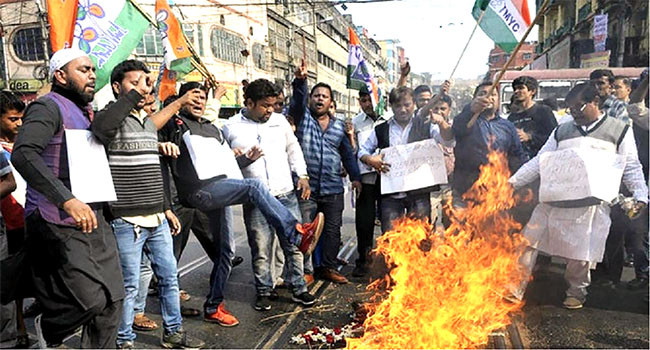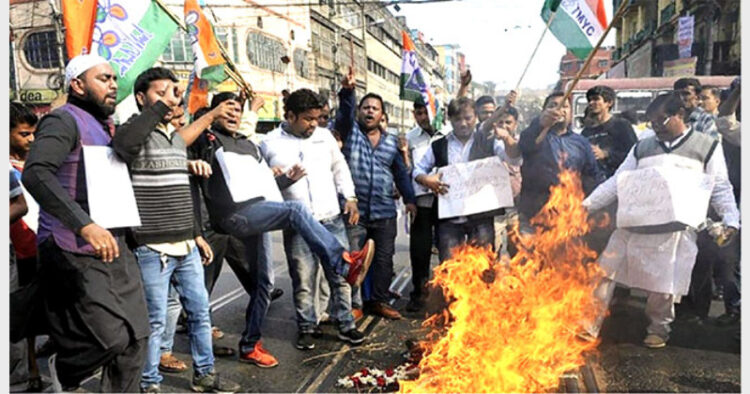Observers say that from the Left regime to the present day in West Bengal, there is a gross undemocratic trend of identifying people who are going against the ruling party and verbally intimidating them. In most cases, the intolerance precipitates into violent attacks
-Suman Bhattacharyya, Kolkata

Bengal has become the hotspot of political violence,
with riots taking place frequently under Mamata Banerjee’s rule
with riots taking place frequently under Mamata Banerjee’s rule
Gauri Naskar, a 37-year old housewife, was killed on May 17, 2008. She was killed in Basanti, South 24 Parganas, a remote area in West Bengal close to the Sunderbans. Gauri, the daughter-in-law of Subhas Naskar, the then Irrigation Minister in the Left Front Government. Gauri was killed by a crude bomb hurled at her residence by CPIM goons.
Subhas Naskar, belonging to the Revolutionary Socialist Party (RSP), had won the Basanti Legislative Assembly seat in 1982, 1987, 1991, 1996,2001, 2006 and 2011. However, his house had also been attacked by political miscreants patronized by CPIM and Subhas could not save his own daughter-in-law. The following day, Ananda Bazar Patrika, Bengal’s most prominent and liberal vernacular daily, carried the news in meticulous detail. The headline was interesting. “Attacked in the Style of the Bandits of Sholay: Subhas Naskar’s House Burnt Down”, it stated. The description of the attack as it was reported would beat any Bollywood potboiler.
The death of Gauri Naskar only proves how CPIM used to control rural Bengal with violence and terror. Even its own allies were not spared. It is ironic but, therefore, not surprising that RSP, a partner of the Left Front, later quit the Left alliance in Kerala and joined the Congress-led UDF.
To understand the tradition of political killings in West Bengal, we must go back to the 1980s, when Jyoti Basu, the then Chief Minister of West Bengal, admitted in a speech in the Legislative Assembly that 86 political workers were reportedly killed during that particular year (1988-89). Of the 86 people killed, 34 were CPIM activists. In 1989, Pradyot Guha, then Youth Congress President in West Bengal, wrote a letter to Rajiv Gandhi. Incidentally, Guha had later served as Personal Secretary of President Pranab Mukherjee. Pradyot Guha recorded in his letter to Rajiv Gandhi that in the first 50 days of 1989 (January-February), 26 political murders had taken place in West Bengal. Guha further noted that of these incidents of murder, 8 alone occurred during the first 19 days of February in Murshidabad.
The present President of All India Mahila Congress, Shrimati Sushmita Dev, who happily shares the stage and participates in different protest rallies with the Left leaders, has perhaps forgotten and forgiven the miscreants who, in 1989, had brutally attacked her father, Santosh Mohan Dev. Dev was at that time a Minister in the Central Government. Santosh Mohan Dev had narrowly escaped death at the hands of these political goons in the Behala area of Kolkata. He was visiting the Behala area as a part of the enquiry team to probe into the edible oil (rapeseed) scam which had resulted in the paralysis and death of several Kolkata residents. The death of prominent opposition leaders under mysterious circumstances was also a regular feature during the 1980s when CPM rule in Bengal had reached its peak.
The accounts of the deaths of ex-MLA Kashinath Tah of Burdwan and Asamanja Dey of Nadia are still remembered by people with great grief and horror. CPIM dissident leader Gautam Bhattacharyya, who hailed from the North 24 Parganas, had formed the Nagarik Mancha (Citizens’ Forum) and challenged his former Party. Bhattacharya was brutally killed under mysterious circumstances.
An analysis of the National Crime Bureau Records establishes that from 1999 to 2016, there have been at least 20 political murders each year in West Bengal. However, this was contested by Derek O’ Brien, Rajya Sabha leader of Trinamool Congress Party. In 2010, Derek tweeted to say that in 1990 alone CPIM had killed 400 of its political opponents. He also claimed that CPIM killed 40 activists of the opposition during the 2003 Panchayat Elections. By the parameters of political violence and cruelty, West Bengal is much above the national standard. This can also be explained from the data provided by the Election Commission. During the 2014 Lok Sabha election, 16 people were reported to have been killed in the entire country. Of them, 7 were from West Bengal. Before this, during the 2009 Elections, altogether 5315 cases of violation of election rules were registered in the country. of these 5315 cases, a total of 18%, i.e., 963 cases were recorded in Bengal. In 2014, this number was 7787 for the entire country, of which, 931 cases alone, approximately 18% of the total cases were from Bengal.
There is also a peculiar trend of poll violence in West Bengal. In other states, most of the violent incidents occur on the day of the election. In the case of West Bengal, however, most of it is post-poll violence where 61% of the total recorded incidents of political violence in the state occurred after the voting was over.
An RTI Enquiry lodged by one Shyamal Mitra in 2011 is an interesting pointer to how political killings take place in West Bengal. This RTI case was filed to understand the first five months of the regime of Mamata Banerjee. It was revealed that 27 people were killed in the first five months, and 128 students were injured due to student politics in the state. Of the 27 people killed, only 5 were TMC supporters.
During the first five months of the regime of Mamata Banerjee, 586 incidents of political violence erupted in different parts of Bengal. Of these 586 incidents again, 56 violent clashes occurred in an attempt to gain control over educational institutions, in the colleges and universities. If the first five months of the TMC rule had claimed the lives of 27 students, then it appears not very strange that the 2018 Panchayat Elections in the state saw the violent death of more than a hundred political activists.













Comments